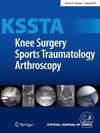Combined PCL instabilities cannot be identified using posterior stress radiographs in external or internal rotation: A cadaveric study.
IF 3.3
2区 医学
Q1 ORTHOPEDICS
引用次数: 0
Abstract
PURPOSE Posterior stress radiography is recommended to identify isolated or combined posterior cruciate ligament (PCL) deficiencies. The posterior drawer in internal (IR) or external rotation (ER) helps to differentiate between these combined instabilities. The purpose of this study was to evaluate posterior stress radiography (PSR) in isolated and combined PCL deficiency with IR and ER compared to PSR in neutral rotation (NR) for diagnosing combined PCL instabilities. METHODS Six paired fresh-frozen human cadaveric legs (n = 12) were mounted in a Telos device for PSR. The tibia was rotated using an attached foot apparatus capable of rotating the foot 30° internally and externally. A posterior tibial load of 15 kp (147.1 N) was applied to the tibial tubercle at 90° knee flexion, and a lateral radiograph was obtained. This was repeated with the foot in 30° IR and ER. The PCL, posterolateral complex (PLC), and posteromedial complex (PMC) were sectioned in six knees, while the PMC was sectioned before the PLC in the other six knees. Posterior tibial displacement (PTD) was measured radiographically. Statistical analysis was performed using a two-way ANOVA and a mixed model with Bonferroni correction, and the significance was set at p < 0.05. Furthermore, intra- and interobserver reliability was determined. RESULTS Cutting the PCL significantly increased the radiographic PTD by 9.8 ± 1.8 mm (side-to-side difference compared to the intact state of the knee, n = 12; p < 0.001). This further increased to 12.2 ± 2.3 mm (n = 6; p < 0.01) with an additional PLC deficiency and to 15.4 ± 3.4 mm (n = 6; p < 0.05) with an additional PMC deficiency. A combined PLC and PMC deficiency resulted in an increase of the PTD to 15.9 ± 4.5 mm (n = 12; p < 0.01). In the PCL/PLC deficient state, ER did not demonstrate a higher PTD, compared to the NR and IR posterior drawer. In the PCL/PMC deficient state in IR, PTD was 1.6 ± 0.7 mm (p < 0.01) higher compared to NR and 3.2 ± 1.9 mm (p < 0.05) higher compared to ER. We showed excellent intra- and interobserver reliability (0.987-0.997). CONCLUSION Combined PCL instabilities resulted in a significant increase in posterior tibial displacement in posterior stress radiographs. However, PSR in IR or ER was unable to differentiate between these combined instabilities. Based on our data, additional stress radiographs in rotation are unlikely to provide any diagnostic benefit in the clinical setting. LEVEL OF EVIDENCE There is no level of evidence as this study was an experimental laboratory study.使用外旋或内旋时的后应力X光片无法识别合并的PCL不稳定性:尸体研究。
目的:建议采用后应力放射摄影来识别孤立或合并的后交叉韧带(PCL)缺陷。内旋(IR)或外旋(ER)时的后牵引有助于区分这些合并不稳定性。本研究的目的是评估在诊断合并的 PCL 不稳定性时,IR 和 ER 下的后应力放射摄影(PSR)与中立旋转(NR)下的后应力放射摄影(PSR)的比较。胫骨通过附带的足部装置旋转,足部可内外旋转 30°。膝关节屈曲 90° 时,在胫骨结节上施加 15 kp(147.1 N)的胫骨后负荷,并拍摄侧位X光片。在脚处于 30° IR 和 ER 时重复上述操作。对六个膝关节的 PCL、后外侧复合体(PLC)和后内侧复合体(PMC)进行切片,对另外六个膝关节的 PMC 在 PLC 之前进行切片。胫骨后位移(PTD)通过X光片进行测量。统计分析采用双向方差分析和混合模型,并进行 Bonferroni 校正,显著性以 p < 0.05 为标准。结果切断 PCL 后,膝关节的影像学 PTD 显著增加了 9.8 ± 1.8 mm(与膝关节完好状态相比的侧向差异,n = 12;p < 0.001),进一步增加到 12.2 ± 1.8 mm(与膝关节完好状态相比的侧向差异,n = 12;p < 0.001)。如果再加上 PLC 缺损,PTD 将进一步增至 12.2 ± 2.3 mm(n = 6;p < 0.01);如果再加上 PMC 缺损,PTD 将增至 15.4 ± 3.4 mm(n = 6;p < 0.05)。同时缺乏 PLC 和 PMC 会导致 PTD 增加到 15.9 ± 4.5 mm(n = 12;p < 0.01)。在 PCL/PLC 缺乏的状态下,与 NR 和 IR 后抽屉相比,ER 的 PTD 并不高。在PCL/PMC缺乏状态下,IR的PTD比NR高1.6 ± 0.7 mm(P < 0.01),比ER高3.2 ± 1.9 mm(P < 0.05)。我们发现观察者内部和观察者之间的可靠性极佳(0.987-0.997)。然而,IR 或 ER PSR 无法区分这些组合不稳定性。根据我们的数据,在临床环境中,额外的旋转应力X光片不太可能提供任何诊断益处。
本文章由计算机程序翻译,如有差异,请以英文原文为准。
求助全文
约1分钟内获得全文
求助全文
来源期刊
CiteScore
8.10
自引率
18.40%
发文量
418
审稿时长
2 months
期刊介绍:
Few other areas of orthopedic surgery and traumatology have undergone such a dramatic evolution in the last 10 years as knee surgery, arthroscopy and sports traumatology. Ranked among the top 33% of journals in both Orthopedics and Sports Sciences, the goal of this European journal is to publish papers about innovative knee surgery, sports trauma surgery and arthroscopy. Each issue features a series of peer-reviewed articles that deal with diagnosis and management and with basic research. Each issue also contains at least one review article about an important clinical problem. Case presentations or short notes about technical innovations are also accepted for publication.
The articles cover all aspects of knee surgery and all types of sports trauma; in addition, epidemiology, diagnosis, treatment and prevention, and all types of arthroscopy (not only the knee but also the shoulder, elbow, wrist, hip, ankle, etc.) are addressed. Articles on new diagnostic techniques such as MRI and ultrasound and high-quality articles about the biomechanics of joints, muscles and tendons are included. Although this is largely a clinical journal, it is also open to basic research with clinical relevance.
Because the journal is supported by a distinguished European Editorial Board, assisted by an international Advisory Board, you can be assured that the journal maintains the highest standards.
Official Clinical Journal of the European Society of Sports Traumatology, Knee Surgery and Arthroscopy (ESSKA).

 求助内容:
求助内容: 应助结果提醒方式:
应助结果提醒方式:


